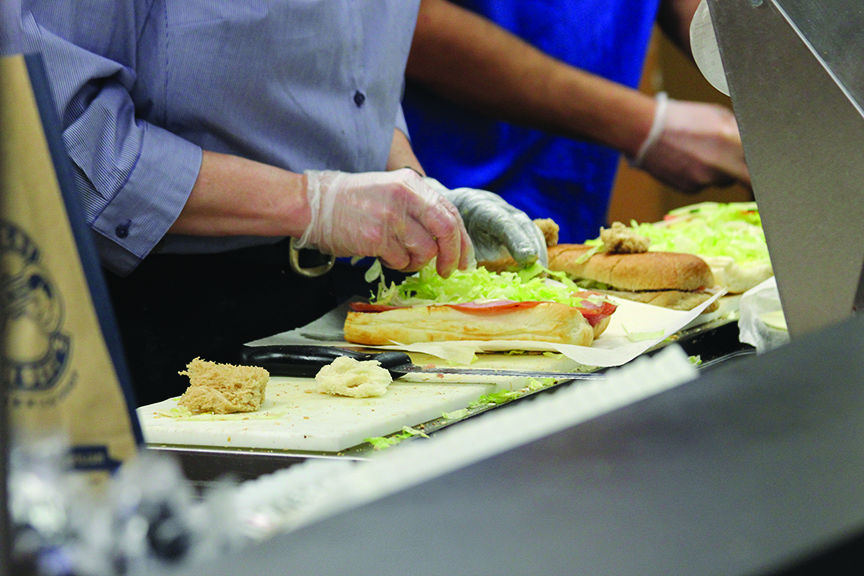Learning how to live Gluten Free no longer a challenge
January 14, 2015
A common trend for college students is finding food that is quick to make and easy to eat between classes, but for college students with Celiac Disease, eating requires more planning and caution.
Alexis Deanna, freshman political science major with economics and global studies minors, was diagnosed with Celiac Disease when she was 16 years old.
Celiac Disease is when “…by eating gluten you are actually causing damage to your body, to your intestines,” said Mariah Weber, a registered dietitian and the Wellness Coordinator.
According to Weber, there are two different types of gluten related disorders: Celiac Disease and Non-Celiac Gluten Sensitivity. Non-Celiac Gluten Sensitivity occurs when a person eats gluten and has the symptoms of Celiac but is not harming their body; they are just uncomfortable.
According to Weber, there is a large range of possible symptoms including: “bloating, basic abdominal discomfort or pain, there could be diarrhea, there’s some constipation, headaches, migraines, there can be muscle aches and pains, basic fatigue or …bone and joint pain.”
“The symptoms [of Celiac Disease and Non-Celiac Gluten Sensitivity] can mimic the same so that’s why it’s important to talk to a provider so you can be tested for the actual Celiac Disease,” Weber said.
Deanna said that she experienced six months of stomach issues before being diagnosed with Celiac Disease.
“My grandma actually had been diagnosed with Celiac Disease five years before that so it’s actually genetic,” Deanna said.
In order to check for Celiac Disease, Deanna had to undergo a blood test that checks for a certain antibody in the blood.
“The gluten-free diet is one of those that is a little more challenging than most because gluten is in a lot of different foods and it can be hidden in a lot of foods as well,” Weber said.
Weber said the main sources of gluten are wheat, barley and rye. But gluten can be found in sauces and gravies, cereals, pasta, salad dressing, food coloring, soups, alcoholic beverages and many more items.
Deanna said that being gluten-free and a college student at the same time can be difficult because gluten-free products are expensive.
“When it comes to eating in cafeterias or something like the market or fast foods … it’s difficult because you don’t know what might have been cross contaminated so you definitely have to side on the err of caution,” Deanna said.
According to Jared Wolf, an Aramark representative, there are no dining locations that are 100 percent gluten-free.
“We do offer foods made without gluten ingredients: the One Stop Rabbit Shop does carry a few items that are gluten-free, and the Hansen C-Store will be getting some gluten-free options in the near future as well,” Wolf said.
Wolf said that if a student has a question to contact dining services or to let the dining workers know about the allergy.
“If you are concerned about cross contamination, make sure the dining worker preparing your food is aware that you are trying to eat gluten-free, so they can take the proper actions to limit the risk of cross-contamination of gluten,” Wolf said.
Deanna said that her best asset trying to navigate being a college student and gluten-free has been Disability Services.
“You can also work with the meal plan a little bit differently so that it better accommodates you and your needs so you don’t have [to] spend unnecessary money,” Deanna said.
According to Weber, people who are diagnosed with Celiac Disease or gluten sensitivity should get in touch with a registered dietitian and try to get education about Celiac or gluten sensitivity.
Weber said students that are eating on campus should look at the Dining Services website.
“There is a pamphlet available in the Market, in our main dining office in the basement of the Union and on our webpage sdsu.campusdish.com that outlines which items are made without gluten ingredients at each dining location,” Wolf said.
“[Dining Services] actually went through this summer and they show every single dining location and all of your gluten free options,” Weber said.
Students who do not live or eat on campus can go to Hy-Vee and speak with the dietitian.
“It’s not recommended to eat gluten-free without having either Celiac or gluten sensitivity,” Weber said.
The gluten-free diet cuts out B vitamins, iron and fiber. Weber said in order for those who need to be on a gluten-free diet that they should choose foods that will help in gaining the nutrients that are missing when gluten is cut from a diet. Instead, eat whole grain gluten-free products, protein, plant foods, legumes, nuts, pork and take a multivitamin.
























